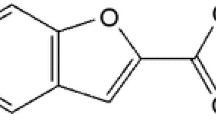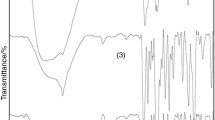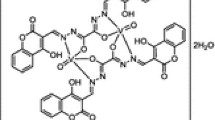Abstract
The coumarilate (coum−) complexes of CoII(1), NiII(2) CuII(3) and ZnII(4) were synthesized and characterized by elemental analysis, magnetic susceptibility, solid-state UV–Vis, FTIR spectra, thermoanalytical TG–DTG/DTA and single-crystal X-ray diffraction methods. It was found that all of the complex structures have 2 mol (coum−) ligand bonded as monoanionic monodentate in the structures of 1 and 2 while they were coordinated to metal cations as monoanionic bidentate in the complexes 3 and 4. There was not any hydrate water in the metal complexes. The complexes of 1 and 2 have four moles of aqua ligand, and the other complexes have two moles. Thermal decomposition of each complex starts with dehydration, and then the decomposition of organic parts goes. The thermal dehydration of the complexes takes place in one (for the compounds of 2, 3, 4) or two (for the compound 1) steps. The decomposition mechanism and the thermal stability of the complexes under investigation were determined on the basis of their structures. Metal oxides were obtained as the final decomposition product.








Similar content being viewed by others
References
Gilchrist TL. Heterocyclic chemistry. Harlow: Longman Group UK Limited; 1985.
Hattori M, Hada S, Watahiki A, Ihara H, Shu YZ, Kakiuchi N, Mizuno T, Namba T. Studies on dental caries prevention by traditional medicines. X. Antibacterial action of phenolic components from mace against Streptococcus mutans. Chem Pharm Bull. 1986;34:3885–93.
Erber S, Ringshandl R, von Angerer E. 2-Phenylbenzo[b]furans: relationship between structure, estrogen receptor affinity and cytostatic activity against mammary tumor cells. Anticancer Drug Des. 1991;6:417–26.
Cui B, Chai H, Reutrakul V, Farnsworth NR, Cordell GA, Pezzutto JM, Kinghorn AD. Novel cytotoxic 1H-cyclopenta[b]-benzofuran lingnans from Aglaia elliptica. Tetrahedron. 1997;53:17625–32.
Lee SK, Cui B, Mehta RR, Kinghorn AD, Pezzutto JM. Cytostatic mechanism and antitumor potential of novel 1H-cyclopenta[b]benzofuran lignans isolated from Aglaia elliptica. Chem Biolog Interact. 1998;115:215–28.
Kodama I, Kamiya K, Toyama J. Amiodarone: ionic and cellular mechanisms of action of the most promising class III agent. Am J Card. 1999;84:20R–8R.
Hayakawa I, Shioya R, Agatsuma T, Furukawa H, Naruto S, Sugano Y. 4-Hydroxy-3-methyl-6-phenylbenzofuran-2-carboxylic acid ethyl ester derivatives as potent anti-tumor agents. Bioorg Med Chem Lett. 2004;14:455–8.
Hwang BY, Su BN, Chai H, Mi Q, Kardono LB, Afriastini JJ, Riswan S, Santarsiero BD, Mesecar AD, Wild R, Fairchild CR, Vite GD, Rose WC, Farnsworth NR, Cordell GA, Pezzutto JM, Swanson SM, Kinghorn AD. Silvestrol and episilvestrol, potential anticancer rocaglate derivatives from Aglaia silvestris. J Org Chem. 2004;69:3350–8.
Masche UP, Rentsch KM, von Felten A, Meier PJ, Fattinger KE. No clinically relevant effect of lornoxicam intake on acenocoumarol pharmacokinetics and pharmacodynamics. Eur J Clin Pharm. 1999;54(11):865–8.
Karaliota A, Kretsi O, Tzougraki C. Synthesis and characterization of a binuclear coumarin-3-carboxylate copper(II) complex. J Inorg Biochem. 2001;84:33–7.
Kossakowski J, Krawiecka M, Kuran B, Stefanska J, Wolska I. Synthesis and preliminary evaluation of the antimicrobial activity of selected 3-benzofurancarboxylic acid derivatives. Molecules. 2010;15:4737–49.
Kossakowski J, Ostrowska K, Hejchman E, Wolska I. Synthesis and structural characterization of derivatives of 2- and 3-benzo[b]furan carboxylic acids with potential cytotoxic activity. Farmaco. 2005;60:519–27.
Kowalewska H, Kwiecien H, Smist M, Wrzesniewska A. Synthesis of new benzofuran-2-carboxylic acid derivatives. J Chem. 2013;. doi:10.1155/2013/183717.
Köse DA, Öztürk B, Şahin O, Büyükgüngör O. Mixed ligand complexes of coumarilic acid/nicotinamide with transition metal complexes. J Therm Anal Calorim. 2014;115:1515–24.
Drzewiecka A, Koziol AE, Klepka MT, Wolska A, Jimenez-Pulido SB, Lis T, Ostrowska K, Struga M. Two coordination modes around the Cu(II) cations in complexes with benzo[b]furancarboxylic acids. Chem Phys Lett. 2013;559:41–5.
Limaye DB, Sathe NR. Syntheses of 6-hydroxy-7-acylcouma- rones. I. 6-Hydroxy-7-acetyl-3-methylcoumarone. Rasayanam. 1936;1:48–54.
Shah NM, Shah PM. Hydroxy-acyl-cumarone, III. Friessche Verschiebung von 5-substituierten 6-acyloxy-3-methyl-cumarilsäuren. Chem Ber. 1960;93:18–24.
Zawadowski T, Kossakowski J, Rechowicz P. Synthesis of 2-methyl-5-hydroxy-6-acetylbenzofuran-3-carboxylic acid and its derivatives. Rocz Chem Ann Soc Chim Polonorum. 1977;51:159–62.
Ng SW. Coordination complexes of triphenyltin coumarin-3-carboxylate with O-donor ligands: (coumarin-3-carboxylato)triphenyltin-l (L = ethanol, diphenylcyclopropenone and quinoline N-oxide) and bis[(coumarin-3-carboxylato)triphenyltin]-l(L = triphenylphosphine oxide and triphenylarsine oxide). Acta Cryst. 1999;C55:523–31.
Castellani CB, Carugo O. Studies on fluorescent lanthanide complexes. New complexes of lanthanides(III) with coumarinic-3-carboxylic acid. Inorg Chim Acta. 1989;159:157–61.
Mihaylov TZ, Trendafilova N, Kostova I, Georgieva I, Bauer G. DFT modeling and spectroscopic study of metal–ligand bonding in La(III) complex of coumarin-3-carboxylic acid. Chem Phys. 2006;327:209–19.
Georgieva I, Trendafilova N, Aquino AJA, Lischka H. Theoretical study of metal–ligand interaction in Sm(III), Eu(III), and Tb(III) complexes of coumarin-3-carboxylic acid in the gas phase and solution. Inorg Chem. 2007;46(25):10926–36.
Georgieva I, Trendafilova N, Creaven BS, Walsh M, Noble A, McCann M. Is the C=O frequency shift a reliable indicator of coumarin binding to metal ions through the carbonyl oxygen? Chem Phys. 2009;365(1–2):69–79.
Roh SG, Baek NS, Hong KS, Kim HK. Synthesis and photophysical properties of luminescent lanthanide complexes based on coumarin-3-carboxylic acid for advanced photonic applications. Bull Korean Chem Soc. 2004;25(3):343–4.
Creaven BS, Devereux M, Georgieva I, Karcz D, McCann M, Trenddafilova N, Walsh M. Molecular structure and spectroscopic studies on novel complexes of coumarin-3-carboxylic acid with Ni(II), Co(II), Zn(II) and Mn(II) ions based on density functional theory. Spectrochim Acta A. 2011;84(1):275–85.
Icbudak H, Heren Z, Kose DA, Necefoglu H. bis(nicotinamide) and bis(N,N-diethylnicotinamide) p-hydroxybenzoate complexes of NI(II), Cu(II) and Zn(II). Spectrothermal studies. J Therm Anal Calorim. 2004;76:837–51.
Sheldrick GM. A short history of SHELX. Acta Cryst. 2008;A64:112–22.
Farrugia LJ. WinGX suite for small-molecule single-crystal crystallography. J Apply Cryst. 1999;32:837–8.
Mercury, version 3.0; CCDC, available online via ccdc.cam.ac.uk/products/mercury.
Spek AL. PLATON—a multipurpose crystallographic tool. Utrecht: Utrecht University; 2005.
Köse DA, Şahin O, Büyükgüngör O. Synthesis, spectral, thermal, magnetic and structural study of diaquabis(salicylato-κO)bis(N,N-diethylnicotinamide-κN)cobalt(II). Eur Chem Bull. 2012;1(6):196–201.
Köse DA, Ay AN, Şahin O, Büyükgüngör O. A mononuclear Zn(II) complex of mixed ligands with both fivefold- and sixfold-coordinations in the same framework. J Iran Chem Soc. 2012;9(4):591–7.
Köse DA, Necefoğlu H, Şahin O, Büyükgüngör O. Synthesis, structural, spectroscopic characterization and structural comparison of 3-hydroxybenzoate and nicotinamide/N,N-diethylnicotinamide mixed ligand complexes with Zn(II). J Therm Anal Calorim. 2012;110(3):1233–41.
Nakamoto K. Infrared and Raman spectra of inorganic and coordination compounds. Toronto: Wiley; 1997.
Köse DA, Gökçe G, Gökçe S, Uzun I. Bis(N,N-diethyl nicotinamide) p-chlorobenzoate complexes of Ni(II), Zn(II) and Cd(II), synthesis and characterization. J Therm Anal Calorim. 2009;95(1):247–51.
Acknowledgements
This work has been supported by Hitit University Scientific Research Unit (Project No: FEF19004.15.005).
Author information
Authors and Affiliations
Corresponding author
Rights and permissions
About this article
Cite this article
Dağlı, Ö., Köse, D.A., Şahin, O. et al. The synthesis and structural characterization of transition metal coordination complexes of coumarilic acid. J Therm Anal Calorim 128, 1373–1383 (2017). https://doi.org/10.1007/s10973-016-6053-y
Received:
Accepted:
Published:
Issue Date:
DOI: https://doi.org/10.1007/s10973-016-6053-y




